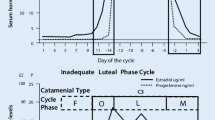Opinion statement
The cyclic hormonal underpinnings of catamenial seizure exacerbations are consistent with the neurophysiologic activity of estrogen and progesterone. For women with catamenial epilepsy who have regular menses, intermittent treatment approaches may be utilized. These interventions are targeted at adding or increasing anti-seizure treatments during established vulnerable days of the menstrual cycle, such as perimenstrually (C1 pattern), at ovulation (C2 pattern), and during the luteal phase (C3 pattern). The single large study of natural progesterone treatment showed benefit for women with clear perimenstrual seizure exacerbations (C1 pattern), but not for subjects with other catamenial patterns or for randomized women with epilepsy of reproductive age who did not have catamenial seizure exacerbations. In this protocol, natural progesterone was given at a high dose during the luteal phase and was generally well tolerated. Other intermittent cyclic treatments include benzodiazepine use, increasing the dose of an anti-seizure drug already in use, or acetazolamide. For women with irregular menses, or those in which the intermittent cyclic treatments are not effective, pharmacologically stopping the menstrual cycle altogether by using synthetic hormones such as medroxyprogesterone (Depo-Provera) or sustained oral contraceptives may be considered.


Similar content being viewed by others
References and Recommended Reading
Papers of particular interest, published recently, have been highlighted as: • Of importance •• Of major importance
Locock C. Discussion. In: Sieveking EH (ed) Analysis of fifty-two cases of epilepsy observed by the author. Med Times Gaz. 1857;14:524–6.
Foldvary-Schaefer N. Introduction. Atlas of epilepsies. London: Springer; 2010. p. 1295–9.
Herzog A, Fowler K, Sperling M, Massaro J, Group PTS. Distribution of seizures across the menstrual cycle in women with epilepsy. Epilepsia. 2015;56(5):e58–62.
Herzog A. Catamenial epilepsy: definition, prevalence, pathophysiology and treatment. Seizure. 2008;17:151–9.
Jones H. Luteal-phase defect: the role of Georgeanna Seegar Jones. Fert Ster. 2008;90(5):e5–7.
Reddy DS, Gould J, Gangisetty O. A mouse kindling model of perimenstrual catamenial epilepsy. J Pharm Exp Therap. 2012;341(3):784–93.
Harden C, Pennell P. Neuroendocrine considerations in the treatment of men and women with epilepsy. Lancet Neur. 2013;12:72–83.
Tauboll E, Sveberg L, Svalheim S. Interactions between hormones and epilepsy. Seizure. 2015;28:3–11.
Woolley CS, McEwen BS. Roles of estradiol and progesterone in regulation of hippocampal dendritic spine density during the estrous cycle in the rat. J Comp Neurol. 1993;336:293–306.
Gazzaley AH, Weiland NG, McEwen BS, Morrison JH. Differential regulation of NMDAR1 mRNA and protein by estradiol in the rat hippocampus. J Neurosci. 1996;16:6830–683.
Smith SS. Estradiol administration increases neuronal response to excitatory amino acids as a long term effect. Brain Res. 1989;503:354–7.
Woolley CS, McEwen BS. Estradiol regulates hippocampal dendritic spine density via an N-methyl-d-aspartate receptor-dependent mechanism. J Neurosci. 1994;14:7680–7.
Finocchi C, Ferrari M. Female reproductive steroids and neuronal excitability. Neur Sci. 2011;32:31–5.
Nicoletti F, Speciale C, Sortino M, Summa G, Caruso G, Patti F, et al. Comparative effects of estradiol benzoate, the antiestrogen clomiphene citrate, and the progestin medroxyprogesterone acetate on kainic acid-induced seizures in male and female rats. Epilepsia. 1985;26(3):252–7.
Herzog A, Klein P, Ransil B. Three patterns of catamenial epilepsy. Epilepsia. 1997;38(10):1082–8.
Herzog A, Progesterone Trial Study Group. Distribution of seizures across the menstrual cycle in women with epilepsy. Epilepsia. 2015;56(5):e58–62.
Herzog A. Intermittent progesterone therapy and frequency of complex partial seizures in women with menstrual disorders. Neurology. 1986;36:1607–10.
Herzog A. Progesterone therapy in complex partial seizures and secondary generalized seizures. Neurology. 1995;45:1660–2.
Herzog AG, Fowler KM, Smithson SD, Kalayjian LA, Heck CN, Sperling MR, et al. For the Progesterone Trial Study Group. Progesterone vs placebo therapy for women with epilepsy: a randomized clinical trial. Neurology. 2012;78(24):1959–66. Major double blinded trial looking at progesterone treatment in women with different catamenial seizure types. Showed significant outcomes in post hoc analysis in C1 subtype with greater than 2 fold increase seizure frequency.
Herzog A. Catamenial epilepsy: update on prevalence, pathophysiology and treatment from the findings of the NIH progesterone treatment trial. Seizure. 2015;28:18–25.
Herzog A, Frye C. Allopregnanolone levels and seizure frequency in progesterone-treated women with epilepsy. Neurology. 2014;83:345–8.
Herzog A, Frye C. Seizure exacerbation associated with inhibition of progesterone metabolism. Ann Neurol. 2003;53:390–1.
Mattson R, Cramer J, Caldwell B, Siconolfi B. Treatment of seizures with medroxyprogesterone acetate: preliminary report. Neurology. 1984;34:1255–8. Strong evidence showing decrease in catamenial seizure exacerbations in women taking large enough amount of MPA to stop ovulatory cycle.
Clark M, Sowers M, Levy B, et al. Bone mineral density loss and recovery during 48 months in first-time users of depot medroxyprogesterone acetate. Fertil Steril. 2006;86(5):1466–74.
Bauer J, Wildt L, Flugel D, Stefan H. The effect of a synthetic GnRH analogue on catamenial epilepsy: a study in ten patients. J Neurol. 1992;239:284–6.
Bergstrom W. Observations on metabolic and clinical effects of carbonic anhydrase inhibitors in epileptics. Am J Dis Child. 1952;84:771.
Lim LL, Foldvary N, Mascha E, Lee J. Acetazolamide in women with catamenial epilepsy. Epilepsia. 2001;42(6):746–9.
Feely M, Calvert R and J Gibson. Clobazem in catamenial epilepsy: a model for evaluating anticonvulsants. The Lancet. 1982. 71–73
Author information
Authors and Affiliations
Corresponding author
Ethics declarations
Conflict of Interest
The authors declare that they have no conflict of interest.
Human and Animal Rights and Informed Consent
This article does not contain any studies with human or animal subjects performed by any of the authors.
Additional information
This article is part of the Topical Collection on Epilepsy
Rights and permissions
About this article
Cite this article
Navis, A., Harden, C. A Treatment Approach to Catamenial Epilepsy. Curr Treat Options Neurol 18, 30 (2016). https://doi.org/10.1007/s11940-016-0413-6
Published:
DOI: https://doi.org/10.1007/s11940-016-0413-6




